Amplifiers do exactly what they say they do: they amplify things or make signals bigger. There are current amplifiers (which increase the current of a given signal whilst maintaining voltage) voltage amplifiers which (which increase voltage and not current) and power amplifiers (which increase the power - this usually involves increasing both voltage and current). More often you'll meet the terms pre-amplifier, line amplifier and power amplifier. You might also come across summing amplifiers or mixing amplifiers.
Probably the most confusing aspect of their use and terminology is concerned with gain and dB (decibel) units used to express that gain. Consider this scenario:
- A microphone has an output of 10mV (0.01V)
- This feeds a pre-amplifier which has an output of 1V
- This feeds a power amplifier which drives a loudspeaker with an output of 10V
Just thinking about voltage for the time being (ignoring current, impedances and so power):
- The pre-amplifier multiplies the voltage by 100 (a gain factor of 100 times)
- The power amplifier multiplies the voltage by 10 (a gain factor of 10 times)
- So the total voltage gain is a factor of 1000 times
But now lets consider currents and things we ignored and look at what's going on with the
power, using P=V
2/R. In all cases I've assumed that the output impedance of all devices is so much smaller than the input impedance of the next device that it can be ignored.
- The microphone drives 10mV into the input of the pre amplifier which has an input impedance of 1kohms - so that's a power of 0.1 microWatts.
- The power amplifier has an input impedance of 10kohms and the pre-amplifier delivers 1V into this. So the pre-amplifier needs an output power of 0.1milli-watts, that's a power gain of 1000 times!
- The speaker has an impedance of 8ohms and the power amplifier needs to deliver 10V into this. So the power amplifier needs an output power of 12.5watts, that's a power gain of 125,000 times!
- So the total gain is 125,000,000 times!!!
So you can see that just thinking about voltages doesn't give anything like the right picture.
Now look at these figures again with decibels:
- For voltages use dB=20log(V2/V1) or 20log(gain factor)
- So this gives a pre-amp voltage gain of 40dB - 20log(1/0.01)
- And a power amp voltage gain of 20dB - 20log(10/1)
- Which gives a total voltage gain of 60dB - 40+20
- For powers use dB=10log(V2/V1) or 10log(gain factor)
- So this gives a pre-amp power gain of 30dB - 10log(0.0001/0.0000001)
- And a power amp power gain of 51dB - 10log(12.5/0.0001)
- Which gives a total power gain of 81dB - 30+51
And here is one of the great advantages of decibels - when dealing with gains and losses, all you need to do add the dB value of each component to get the overall gain or loss; there's no messing about with multiplication or hideous divisions.
Pre-amplifiers and power amplifiers etc
In our world of audio engineering we deal with a variety of signal levels:
- Low level signals
- Such as those generated by microphones or other transducers. These are often called mic level. Sometimes such signals are processed for some reason e.g. the RIAA curve applied to 'flatten out; the response of a record cartridge output.
Typically these signals are in the millivolt or 10's of millivolts order. Some condensor mics can push out levels approaching or exceeding whole volts but they have pre-amps in them.
- Intermediate level signals
- Most signal distribution is done at this level and so it is usually called line level. Links between mixers and processor or mixers to amplifiers, for example. Signal processing is usually done at this level - compressors, gates reverb units etc, although some are designed to work directly on mic levels.
Typically these signals are in the hundreds of millivolts or low volts range - i.e. around 0dBu. Note that line level signals are usually enough to drive headphones directly1. Although I would recommend this for any practical purposes except for testing and emergencies.
- High level signals
- These are signals used to drive loudspeakers and are usually of the order of volts or 10's of volts at relatively high current values, for example 300W into 8Ω is around 50V at just over 6A. Hence much heavier grades of cable are used for speakers.
The term
pre-amplifier is usually given to the device that raises low level signals to line level (see the gain calculation example above). Any equalisation or correction that needs to be applied is done in this circuit - e.g. the RIAA correction curve for records.
The term
line amplifier is usually given to a devices used for sending line-level signal over distances e.g. mixing console outputs. These devices are usually unity gain (the same level in as out) but offer lower impedance outputs with higher current delivery. Poor line amplifiers can have a very detrimental effect on your final audio quality. If you are using a good quality mixing desk and lesser equalisers, for example, listen to the difference between feeding your amplifiers from the console output and from the equaliser output over a long cable run. Here is one reason why it is often far better to use
inserts for such processing.
The term
power amplifier is used for devices used to take the line level signals and turn them into the high power signals needed to drive loudspeakers. The importance of high quality power amplifiers in any system cannot be overstated.
The term
mixing amplifier is used to describe the device used to combine individual signals and
mix them together. Mixing consoles are all designed around them and you will rarely find them as stand alone units.
1 - A useful item for your toolbox is a female XLR (cannon plug) with pins 2&3 wired to the tip and ring of a headphone socket. This effectively wired the two headphone drivers in series across the output of the line source connected to other end of of your cable. Even with a modest -10dBu signal driving into this cable you will hear it in a pair of headphones connected in this way and so you can use it for tracing cable breaks or patching errors:


In this case the fault lies in the cable lining the patching system to the destination
If you don't have such an adaptor to hand you can hold the tip and ring of your headphones against pins 2 & 3 carefully avoiding shorting everything out to the can of the XLR.
 this page as a PDF file
this page as a PDF file
 home
home
 back
back

